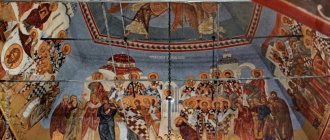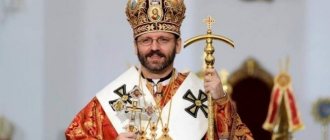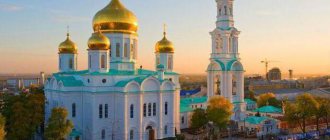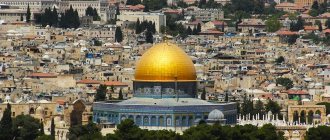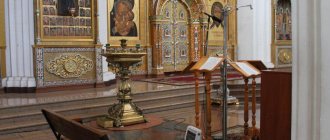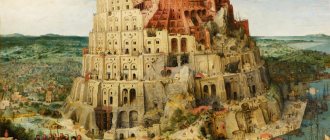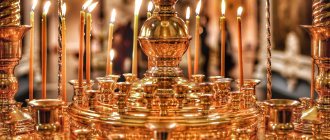THOMAS
What was the Christian Church like at the very beginning? How were the first liturgies performed? What did the apostles talk about in their sermon to Jews and pagans? What difficulties did the apostles and early Christian communities face? About this for the birthday of the Church, the feast of Pentecost, in the new material of “Thomas”.
Robert Leinweber. The Descent of the Holy Spirit on the Apostles
On the 40th day after the Resurrection, Christ, in front of His Mother and a few disciples and followers, ascended from this visible earth to the invisible Heaven (Acts 1:9-11).
However, the Lord, leaving His disciples, told them that He was not leaving forever, that He would return to judge the world. Christ did not abandon the apostles alone on this earth. He promised them that the Holy Spirit would come to them and never leave them. The Lord directly calls Him “Comforter”: “And I will pray the Father, and he will give you another Comforter, that he may abide with you forever, the Spirit of truth, whom the world cannot receive, because it neither sees Him nor knows Him; but you know Him, for He abides with you and will be in you” (John 14:16-17).
When He comes, something completely new will appear in this world. A Church will arise that will live by the Holy Spirit and at the head of which will stand Christ Himself. No one will ever be able to defeat this Church. She will exist until the very end, comforting everyone who wants to be with Christ, helping on his difficult life path, transforming his soul and body with her Sacraments.
The Church is the most precious gift given to man by God. This is the Body, the organism in which the life of Christ flows. And this organism is created by the Holy Spirit, as the Apostle Paul writes. “For just as the body is one, but has many members, and all the members of one body, although many, form one body, so is Christ. For we were all baptized into one body by one Spirit, whether Jews or Greeks, slaves or free, and we were all given one drink of one Spirit” (1 Cor 12:12-13).
What did the apostles do after the Ascension of Christ?
The disciples and followers of Christ returned to Jerusalem, awaiting the fulfillment of the promise that the Lord had given them. The Apostle Luke tells very little about the period between the events of the Ascension of the Lord and the Descent of the Holy Spirit. However, this is enough to imagine the state of the followers of the God-Man, to discern already in this period of “waiting” the emerging features of the future Church.
Ascension. Descent of the Holy Spirit. Dormition. The image is reproduced from the publication: Holy image, hallowed ground: icons from Sinai. Los Angeles: Getty Publications, 2006.
“All of them,” it says in Acts, “continued with one accord in prayer and supplication, with certain women and Mary, the Mother of Jesus, and with His brothers” (Acts 1:14). It is the common unity, the indissolubility of Christians that will be emphasized by the Apostle Luke and later - after Pentecost. And this is no coincidence.
The Apostle constantly directs the reader’s gaze to the most important condition and meaning of life in the Church. The unanimity of believers overcomes the atomism and “dispersion” of individual individuals. It is within the Church that they find the immediacy of mutual communication. The seemingly insurmountable boundaries of egoism are destroyed here and a person, without losing his individuality, becomes part of a single organism, part (attention!) of the Body of Christ Himself. This is the highest status of one who enters the Church.
The same Apostle Luke, in the last verses of his Gospel, notes that the disciples of Christ after the Ascension of their Teacher “were always in the temple, glorifying and blessing God” (Luke 24:53).
Literature
- Armstrong K.
St. Paul. The Apostle We Love to Hate = St. Paul: The Apostle We Love to Hate (Icons) . - M.: Alpina Non-fiction, 2016. - 250 p. — 2000 copies. — ISBN 978-5-91671-601-6. - Bulgakov S. N.
Early Christianity and modern socialism: Two Cities. - M., 1911. - Pavlov I.
How the first Christians lived and what they believed: The Teaching of the Twelve Apostles. - M.: Eksmo, 2021. - 736 p. — ISBN 978-5-04-004369-9. - Sventsitskaya I. S.
Early Christianity: pages of history. - M.: Politizdat, 1978. - Sventsitskaya I. S.
Secret writings of the first Christians. - M.: Politizdat, 1980. - 196 p. — ISBN 5-87245-027-3. - Sventsitskaya I. S., Trofimova M. K.
Apocrypha of ancient Christians. - M.: Mysl, 1989. - 336 p. — ISBN 5-244-00269-4. - Spassky A. A.
Hellenism and Christianity. History of literary and religious polemics between Hellenism and Christianity in the early period of Christian history (150-254). - St. Petersburg. — 2006.
What does “glorifying” and “blessing” mean?
These are two special types of serving God. The blessing is a traditional Jewish prayer that begins with the words “Baruch ata Adonai” and is literally translated as “Blessed are You, the Lord our God.” And the fact that Christ’s disciples “glorified” God means that in the temple they constantly read the Psalter, which is literally translated from the Hebrew language as “praise.”
In addition, before Pentecost, among the disciples of Christ, on the initiative of the Apostle Peter, it was decided to cast lots and elect a new, 12th apostle instead of Judas, who committed suicide. The replenishment of the number of apostles is especially important because it once again emphasizes the authority that they already possessed then, as direct witnesses of the resurrection of Jesus Christ and as those whom God Himself personally chose: “You did not choose Me, but I chose you” (John. 15:16).
It was in this that their very special, incomparable status was revealed, which later placed them at the head of the Church. The apostles chosen by God Himself laid down in the Church its internal priestly hierarchy. And the entire long line of subsequent bishops is directly connected with the disciples of Christ through the chain of ordination.
“And this significance of the Twelve,” writes Archpriest Alexander Schmemann, “as the foundation and focus of the Church, is so indisputable, so obvious for the first community that even before Pentecost its first task will be to replenish their number: to replace Judas, who turned out to be a Traitor.”
The election of a new apostle was perceived by the community as an election by God Himself: “And they prayed and said: Thou, O Lord, knowest the hearts of all, show of these one of thine one whom Thou hast chosen to accept the lot of this ministry and apostleship” (Acts 1:23).
Meanwhile, the Jewish holiday of Pentecost was approaching - Shavuot, dedicated to the memorable events of antiquity, when on the 50th day after the exodus of the Jews from Egypt, God gave them the Law (Ten Commandments) on Mount Sinai (Exodus 19). On the eve of the celebration, huge crowds of pilgrims from different parts of the Roman Empire flooded Jerusalem. However, no one, not even the apostles themselves, suspected that just as shortly before this the Old Testament Passover had been abolished by Christ Himself and a new one was established by Him, so now the “old Shavuot” with the rising of the sun would have to be abolished in the face of the new.
Notes
- Armstrong, 2021, p. 34.
- Formally, the final separation occurs with the “exclusion of Christians from synagogue life after 70 AD.” (S.S. Averintsev, encyclical article “Christianity”, Sofia-Logos. Dictionary
, Kiev, 2006, p. 484).
The curse on heretics ( birkat ha-minim
), adopted at the Sanhedrin in Jamnia around 90, may also apply to Jewish Christians.
However, the interpretation of birkat ha-minim
as a “curse on Christians” has recently come under serious criticism (see, for example, Boyarin, D. 'Justin Martyr Invents Judaism',
Church History
, 70, 2001, pp. 427-461). - James D. Dunn.
Unity and diversity in the New Testament. - M.: BBI, 1999. - ↑ 1 2 3 Christianity
- article from the Electronic Jewish Encyclopedia - Eg, see textbooks: - * Archpriest Alexander Rudakov. History of the Christian Orthodox Church.
St. Petersburg, 1913, p. 20 // § 12 “Persecution of Christians from the Jews.”
— * N. Talberg. History of the Christian Church.
M., 1991, p. 23 // “Persecution of the Church by the Jews.” - Apostle James, brother of the Lord Orthodox Church calendar
- Archimandrite Philaret. Outline of church and biblical history.
M., 1886, p. 395. - “The Sin of Anti-Semitism” (1992), priest, prof. biblical studies Michal Tchaikovsky
- OK. 13:34-35 and Matt. 23:37-39
- Dates taken from: Bruce M. Metzger, The New Testament: Context, Formation, Contents
. M., BBI, 2006, pp. 196-197. For a more detailed and somewhat different proposed dating (both in years and in dating accuracy down to months and, in some cases, days), see: New Bible Dictionary, Part 2, St. Petersburg: Mirt, 2001, pp. 923-926. In particular, this edition proposed May 24, 33 as the date of Pentecost.
Why is Pentecost called the “birthday” of the Church?
When morning came, the apostles, together with the Mother of God, gathered in the Upper Room of Zion - in the very room where, shortly before, Christ celebrated the last Old Testament Easter and established the Sacrament of the Eucharist. Perhaps, in this room, already familiar and dear to them, they wanted to celebrate the holiday of Shavuot together. But at nine o’clock in the morning an amazing thing happened: “And suddenly there came a sound from heaven, as if from a rushing strong wind, and it filled the whole house where they were sitting. And cloven tongues as of fire appeared to them, and one rested on each of them. And they were all filled with the Holy Spirit, and began to speak in other tongues, as the Spirit gave them utterance” (Acts 2:2-4).
A strange noise - soft but booming, like the wind in the hour before a thunderstorm - immediately attracted attention. From all sides, people flocked to the Zion Upper Room, driven by curiosity. When the apostles went outside, a huge crowd of people had already gathered near the building. There were not only Jews here, but also Romans, Parthians, Libyans, Cappadocians, in a word, all those proselytes (people converted from paganism to Judaism) who arrived in the capital to celebrate Shavuot.
And when the apostles began to speak, each person in this multilingual crowd realized that he was hearing his own native language. Some were perplexed in amazement and asked each other: “What does this mean?” And others began to laugh at the disciples of Christ, saying: “They were drunk with sweet wine” (Acts 2:13).
However, the laughter immediately subsided as soon as the Apostle Peter addressed those gathered with the first sermon of the Gospel. With what authority, persuasiveness, and inspired power he delivered it, it can be seen that at the end of his speech, about 3,000 people believed in Christ and received Baptism (Acts 2:41), forming the first Christian community.
So, Pentecost is the day when the Church was born. Why? Because all seven church Sacraments established by Christ are performed by the Holy Spirit - His mysterious action.
The apostles were given a new power, and by the nature of its action it had no earthly analogues. It was given not for domination and intimidation, but to correct the distortion of human nature, unlock the fixation on oneself, transform not only the spiritual, but also the physical principle in man. Proof of the effectiveness of this special power of the Holy Spirit, which has been active in the Church for more than two thousand years, is thousands and thousands of Christian saints.
Moreover, within the Church, formed on the 50th day after the Resurrection of Christ, the boundaries dividing humanity by nationality are removed. And the apostles speaking different languages are a symbol of the fact that the preaching of the Gospel concerns every person, no matter where he lives and no matter what he believes.
From now on, all the artificial walls erected by human fears, mistrust and hatred were destroyed, as the Apostle Paul writes about this: “And now you put everything aside: anger, rage, malice, slander, filthiness of your lips; speak no lies to one another, having put off the old man with his deeds and put on the new man, who is renewed in knowledge after the image of Him who created him, where there is neither Greek nor Jew, circumcision nor uncircumcision, barbarian, Scythian, slave, free, but all and in all things Christ” (Col. 3:8–11).
Such an uncompromising removal of boundaries - both linguistic, national, and social - was completely sensational for the world of that time.
And the sermon with which the apostles subsequently turned to the pagans, first of all, struck the latter with some kind of “intolerance” that was completely unusual for them. From the very beginning, Christ's disciples spoke about the absolute uniqueness of the truth that was revealed to them. They did not try to get along comfortably with the cults around them; on the contrary, they radically rejected them, were ready to go to torment and death, but did not accept - even just for the sake of appearance - the delusions of other people.
How was it possible to bring such a revolutionary message to all peoples in the Roman Empire and even beyond its borders? How did an insignificantly small group of Christ’s disciples, located in one room, manage not to dissolve in the huge mass of all kinds of beliefs? Why the Roman emperors - with their power and strength! – and failed to erase Christianity from the face of the earth? The answer to these questions is given by the Apostle Luke: thanks to the descent and action of the Holy Spirit.
Christ ascended to heaven - it turns out that He left the disciples alone?
On the fortieth day after the Resurrection, Christ, in front of the eyes of His Mother and a few disciples and followers, ascended from this visible earth into Heaven, invisible to us (Acts 1:9-11). Leaving his disciples, the Lord told them that He was not leaving forever, that He would return to judge the world. Christ did not abandon the apostles alone on this earth. He promised them that the Holy Spirit would come to them and never leave them. The Lord directly calls Him the Comforter: And I will pray the Father, and he will give you another Comforter, that he may abide with you forever, the Spirit of truth, whom the world cannot receive, because it neither sees Him nor knows Him;
but you know Him, for He abides with you and will be in you (John 14:16-17).
When He comes, something completely new will appear in this world. A Church will arise that will live by the Holy Spirit and at the head of which will stand Christ Himself. No one will ever be able to defeat this Church. She will exist until the very end, comforting everyone who wants to be with Christ, helping on his life’s path, transforming his soul and body with her sacraments. The Church is the most precious gift given to man by God. This is the Body, the organism in which the life of Christ flows. And this organism is created by the Holy Spirit, as the Apostle Paul directly writes about this: For just as the body is one, but has many members, and all the members of one body, although there are many, form one body, so is Christ. For we have all been baptized into one body by one Spirit, whether Jew or Greek, slave or free, and we have all been given one Spirit to drink.
(1 Cor 12:12–13).
What was the Church like immediately after its “birth”?
The church at the initial stage of its existence outwardly seemed more likely to be just a community of friends of Jesus than some completely new and unique religious phenomenon. In fact, only the confession of Jesus crucified and resurrected as God and the Messiah was the distinctive feature that distinguished the Christians of that time from the many outwardly similar religious branches of Judaism.
Moreover, if you carefully read the first chapters of the book of Acts, you will notice that the Jerusalem community did not yet separate itself from the Jews. The apostles continued to perform all the required prayers at the prescribed hours, preserved the entire Old Testament religious way of life, and the Christians themselves unanimously stayed in the temple every day (Acts 2:46), that is, in the very only Jewish temple in Jerusalem.
And in their preaching, the disciples of Christ still turn only to their compatriots, hoping that they will finally accept Jesus as the Messiah and, like them, will enter the Church established by God by being baptized.
However, such loyalty of the first Christians to Judaism was not at all a relic of the past, from which the Church would gradually free itself. On the contrary, Christians believed that they understood the true meaning of the Old Testament and the entire ritual life of the Jews. That all Judaism only makes sense when faith in Jesus Christ is at the center of it.
The Old Testament was a shadow of the New, and only through the Incarnation did it receive its final and complete meaning, and the good news of the Resurrection of Christ is the necessary key to deciphering the entire Old Testament history.
But the first Christians, of course, did not limit themselves to just observing Old Testament rituals. The center of their religious life even then - in the very first days - was the Eucharist, which was celebrated every day and in which the whole community participated: “breaking bread from house to house, they ate their food with joy and simplicity of heart” (Acts 2:46).
We can understand how these first liturgies were performed if we turn to one early Christian text - the Didache, dating from the end of the 1st - beginning of the 2nd century after the Nativity of Christ:
“As for the Eucharist, give thanks like this. First of all, about the cup: we thank You, Our Father, for the holy vine of David Your servant, which You showed to us through Jesus Your servant. Glory to you forever! As for the broken bread (give thanks thus): We thank You, Our Father, for the life and knowledge that You have revealed to us through Jesus Your Son. Glory to you forever! Just as this broken bread, being scattered over the hills and being gathered, became one, so may Thy Church be gathered from the ends of the earth into Thy Kingdom. For Yours is the glory and the power through Jesus Christ forever. Let no one eat or drink from your Eucharist except those baptized in the name of the Lord.”
The word “liturgy” itself is translated from Greek as “service”, “common cause”. And this “common work” was accomplished during the “ecclesia” (ἐκκλησία). “Ekklesia” is a special civil term. It denoted a competent assembly of citizens of the ancient polis, which gathered to solve the most important economic or political problems. And for the people of antiquity, no matter how strange it may sound to us today, nothing was more important than participation in the political life of the polis. It was the most important privilege, right and duty of a citizen to come to the meeting and have his say. And Christians, in order to emphasize the enormous importance of the Church and the liturgy for the community, began to use this term, which was most important for the civil consciousness of that time.
Thus, the Church is not some kind of structure, as some people think today. No, the Church is an event that happens during the “common cause,” that is, the liturgy. The early Christians perceived their participation in the Eucharist as something absolutely necessary. This responsibility of a Christian before God is akin to civil responsibility: to come and form an ecclesia together, to partake of the Body and Blood of the Lord Jesus Christ.
Therefore, anyone who did not participate in the liturgy did not partake of the common Chalice with everyone else, and strictly speaking, was not a Christian. Because he did not fulfill his main responsibility and was outside the ecclesia, outside the Church.
It was precisely this sense of deep mutual responsibility among the Christians of the Jerusalem community that strengthened their amazing unanimity, which we have already spoken about above and which the Apostle Luke never tires of emphasizing: “The multitude of those who believed had one heart and one soul” (Acts 4:32).
The ideal of unity permeated the community throughout. It extended not only to liturgical life, but also to everyday life: “Not a single word,” writes Alexander Schmemann, “is repeated as often in early Christian writing as the word “brothers,” but Christians invest their entire life in this brotherhood, active meaning."
And the community of property that the early Christians had is one of the manifestations of their complete unity and mutual love. “All believers were together and had everything in common. And they sold estates and all property and distributed it to everyone, depending on the need of each... No one called anything of his estate his own and there was no one in need among them, for everyone who owned lands or houses, selling them, brought the price of what was sold and laid it at their feet the Apostles, and it was given to each one whatever he needed” (Acts 2:44–45, 4:32–35).
It is important to understand that the community of property of the first Christians was not connected with any external economic or social considerations; it was not at all some kind of “early Christian communism.” Everyday life itself in its small everyday details, with its tediousness, pettiness, and monotony, was completely transformed within the early Church: all human relationships were reconfigured here to a completely new way, which had no analogues in the past, the way of love.
Of course, later this idealistic unity gradually begins to corrode. In the Christian communities founded by the apostles inside and outside Palestine, disputes and sometimes conflicts flared up. But the image of the Jerusalem community in the first years of its existence will forever remain the standard of evangelical life for all subsequent generations of Christians.
What difficulties did the early Christians face?
The first difficulty, which arose before Christians almost at the very beginning and then was constantly present in their lives until the 4th century, came from outside - from persecutors and enemies of the Church. Representatives of the official Jewish religion kept a wary eye on the apostles and followers of Jesus. The high priests could not decide how to relate to this new, as they thought, “sect.”
On the one hand, as we have already said, Christians consistently and even exemplarily corrected all religious rituals, and on the other hand, they preached the Risen Jesus, whose death the Jewish hierarchy so zealously sought, and then also paid well the soldiers who stood at the tomb of Jesus so that they no one was told about the miracle of His Resurrection.
There was a debate about this in the Sanhedrin. At one of these meetings, the most prominent and respected Pharisee Gamaliel urged not to begin open persecution and to patiently observe the Christian community, because “if this enterprise is from men, it will be destroyed, but if it is from God, then you cannot destroy it” (Acts 5: 38–39). But they did not heed the advice of the wise Pharisee.
Nikolai Ivanovich Feshin – Exit from the catacombs after prayer (1903)
The first Christian martyr to die at the hands of his compatriots will be Stephen - he will be stoned to death. Immediately after the murder, as the Apostle Luke writes, “there was a great persecution against the Church in Jerusalem, and everyone except the apostles was scattered throughout various parts of Judea and Samaria... and those who were scattered went around preaching the word” (Acts 8:1-4).
It was during this period that the initially zealous persecutor of the Church, brought up in the radical conservative Jewish tradition, Saul, who is known to us as Paul, would experience a radical internal revolution and become the greatest apostle, the deepest Christian thinker, the author of 14 epistles, which were later included in the New Testament.
However, the flight of the followers of Jesus from Jerusalem after the first persecution began (approximate date - 36 AD) turned out to be providential. Indeed, thanks to him, the preaching of the Good News began to spread beyond the borders of Palestine - in the Middle East and further, to the western Mediterranean. Not only proselytes, but also former pagans begin to accept baptism.
Precisely in connection with this, Christians faced a new difficulty - this time internal. An extremely difficult question arose: is it necessary for the newly formed Christian communities consisting of former pagans (and there were more and more of them in the Church) to observe all the ritual instructions of the Old Testament, including undergoing the rite of circumcision? And the first person to answer this question with a decisive “no” was the Apostle Paul.
However, not all Christians agreed with him: “Some who came from Judea taught the brothers: unless you are circumcised according to the rite of Moses, you cannot be saved. When there arose a disagreement and considerable contention between Paul and Barnabas and them, they decided that Paul and Barnabas and some others of them should go to the apostles and elders in Jerusalem regarding this matter” (Acts 15: 1-2).
Christians who came from the Pharisees especially insisted on the pagans' observance of the Law of Moses. And then it was decided to convene the first church council, which took place in Jerusalem in 48 (Acts 15).
Not only the disciples of Christ took part in the Council, but also the entire priestly hierarchy of the local community, headed by the Apostle James at that time. As a result, the legalistic position did not receive support: the pagans who became Christians were freed from the correction of Old Testament rituals. “You know,” said the Apostle Peter at the Council, “that from the first days God chose me from among us, so that from my mouth the pagans would hear the word of the Gospel and believe. And God, the Knower of the Heart, gave them a testimony, giving them the Holy Spirit, as he did to us; and made no difference between us and them, purifying their hearts by faith. Why are you now tempting God, wanting to place on the necks of the disciples a yoke that neither our fathers nor we could bear? But we believe that through the grace of the Lord Jesus Christ we will be saved, just as they were” (Acts 15:7-11).
However, ahead of Christians lay a long and, in the literal sense of the word, painful defense of their faith: for almost three hundred years the Church existed, remaining outside the law. And the more widespread the preaching of Christians became, the more severely the Roman authorities punished adherents of what officials believed was a politically dangerous new religion.
The person who was baptized understood that he was committing an illegal act, because the religion of which he was becoming a professor was prohibited in the territory of the Roman Empire. After all, Christians, being exemplary and law-abiding citizens, flatly refused to honor the cult of the Roman emperor, and this, in the eyes of those in power, was an open demonstration of their disloyalty.
And although thousands and thousands of martyrs, having endured terrible torture and humiliation, will testify to the entire world of that time the unconditional truth of their faith, all Christian life, including liturgical life, will for a long time pass in secret - in their homes or in the catacombs - among the graves, from where to The first iconographic images left by believers of the persecuted Church have survived to our days.
And only in 313, after the publication of the Edict of Milan, large-scale persecution stopped. The huge and seemingly uninterrupted mechanism of Roman power, when confronted with the Church, malfunctioned. After all, the harsher and more mercilessly the emperors acted, the stronger, louder and more convincing the preaching of Christianity sounded.
How ancient Christians prayed
The development of the Christian gastronomic tradition in the first centuries of the history of the Church largely followed the customs of the countries adjacent to the Mediterranean Sea (in historiography, this entire region is traditionally called the Mediterranean). After all, it was here that the first Christian communities were formed. The diet of believers, although it had some peculiarities, was still determined by the realities in which they lived. Therefore, it is worth saying a few words about the tastes and preferences of the peoples of the Roman Empire.
Poultry, fish, dates, asparagus and seafood. 1st century Mosaic, Vatican Museums.
Its basis was three indispensable elements: bread, olive oil and wine, and in addition various cereals, fish (primarily sea), meat and poultry, vegetables (cucumbers, celery, onions, lettuce), fruits (figs, figs, apples , pears, plums, cherries), legumes, dairy products. From combinations of these products, Roman cooks created dishes for rich gourmets that amazed their contemporaries (and descendants) with their whimsicality and sophistication.
Longer than in other regions, local culinary habits were preserved in those provinces where they were supported by the authority of religious tradition, which sometimes strictly tabooed the consumption of certain foods. Probably the most severe were the gastronomic prohibitions adhered to by the Jews, who made up the majority of the inhabitants of the province of Judea. The law prohibited Jewish believers from eating pork, camel meat, hare meat, certain types of fish, and mixing meat and dairy dishes.
The only gastronomic taboo that was strictly observed in most early Christian communities was the ban on offerings to idols. The practice of making blood sacrifices was common among almost all Mediterranean peoples. In the Roman Empire, after the slaughter, part of the carcass was usually ritually burned, and the other was distributed to the poor or sold for the benefit of the priest at the bazaar along with ordinary meat.
The Apostle Paul spoke in his First Letter to the Corinthians that Christians should neither participate in the ritual feasts of the pagans, at which they consumed food sacrificed to idols, nor buy such meat. It is important to note that Paul urged his flock to refrain from such a meal due to the fact that it could wound the conscience of weak Christians in the faith. However, this ban was effective only if the origin of the meat was specifically reported. The meat sacrificed to idols bought at a trade was quite suitable for food if the Christian did not know that it was dedicated to pagan gods: Eat everything that is sold at a trade without any examination, for peace of conscience (1 Cor 10:25). However, apparently many Christians preferred not to tempt fate and still sought to find out about the origin of the meat they were buying. This is particularly pointed out by Pliny the Younger (an ancient Roman politician; c. 61–113). In his letter to Emperor Trajan, he noted with displeasure that, thanks to the spread of Christianity in the province of Bithynia, there were almost no buyers for meat sacrificed to idols.
Usually, during agape, simple but satisfying dishes of vegetables, fruits, and meat were eaten (however, many Christians of the 1st–2nd centuries refused meat altogether). Very often fish appeared on the table, which was considered the most decent food for a Christian due to its repeated mention in the Gospels. Drinks included wine and water. Sometimes community members could take some of the food home.
In the home circle of the first Christians
Koryazhemsky Nikolaevsky Monastery. Arhangelsk region.
If some lucky person were able to see how the morning began in the home of a Christian in the first centuries, he would be both surprised and delighted. He would be amazed that, it turns out, Christians of the primal church have many common features with the life of a modern parishioner, although things (clothing, utensils, bed) are very different from the things he is familiar with. Admired - because I would see completely different, pure and strict relationships that are now impossible.
Life is harsh and simple. Clothes and shoes are rough, much less comfortable than ours. Men wear tunics and cloaks in cold weather. A cloak is a fairly heavy large piece of woolen fabric. The sun had not yet risen, but the owners of the house were already up. It should be taken into account that they rested for a short time, about three hours. And some didn’t sleep at all. The Liturgy was celebrated at night, almost secretly. But no fuss or slowness in faces and movements. Residents of the house have no need to show others and themselves their humility.
Having looked more closely at the surroundings, the traveler would have understood why this house seemed so familiar to him. There is nothing in it that would be reminiscent of antiquity: a pagan shrine filled with strange figurines that seem to be toys. Here, a libation is not offered to the larams at the beginning of the meal, but a psalm is sung, glorifying the Savior.
Basil the Great performs a proskomedia. Fresco. Cathedral of Hagia Sophia. Ohrid, Macedonia. XI century
There is nothing in the clothes of the residents of the house that would distinguish them from their neighbors. Although this is at first glance strange to our church-going contemporary. After all, you need to dress Orthodoxy, fortunately there is such an opportunity! There is no noticeable sloppiness or negligence in the appearance of the owner and hostess. Nor, on the contrary, arrogance. Like, we are different, we are God’s people and must teach everyone about life. Perhaps there are some secrets. The housewife, for example, wears a simple tunic and stola, and the stola is supported by a leather belt. This belt is not decorated with gilding and patterns, like many young women, and is not a subject of boasting: after all, over such a gilded patterned belt you can wear a transparent cape and show off your figure.
However, there are too many stories about clothes. The inhabitants of the house gathered for a meal. There is a big day ahead, filled with work. The night full of dangers is behind us. But God was merciful, the Liturgy was performed, everyone partook of the Holy Mysteries. A trace of the solemn radiance still remained on their faces.
As you know, labor in late antiquity was considered the lot of slaves. A free person should not work. Christians have turned the concept of man on its head. It is a free person who works, because work, as an image of prayer, gives a person freedom in Christ. Free for a Christian means not a slave of passions, but a son of the Heavenly Father, as the Lord said at the Last Supper. Therefore, the first Christians were wary of idleness.
last supper
Do you not know, O man, that you must offer the firstfruits of your heart and your tongue to God every day?
So, the whole family gathered for a meal. This is a simple family, there are no priests, no deacons, no deaconesses. Sometimes they host a traveling Christian for an overnight stay, or even for a few days. So it is now. The guest came out to eat with the hosts. What is important: the residents of the house do not pray separately, each in their own corner. They always pray together, and then disperse, each returning to his own occupation.
It would probably be unbearable for me to exist in a world where every breath is as dense as fabric, and that breath is a prayer. It is impossible in this world: I will pray after the meal, and then go to the computer to finish writing an article and drink tea. But this world is attractive, and I would like to live there. And this desire... leads to prayer.
The first Christian communities came out of the Jewish one, the connection with it was direct. Christians also took over from the Jews the custom of praying at the third, sixth and ninth hours of the day. But only these prayers had a New Testament meaning. At the third hour, the Lord sent down the Holy Spirit to his apostles. The Holy Spirit, as we know from the book of Acts (chapters 9 and 10), was not received by all Christians through Holy Baptism. However, those who believed with all their hearts were honored to receive the Holy Spirit immediately after Baptism. At the sixth hour, the Lord Jesus Christ was nailed to the cross. On the ninth he gave up his spirit into the hands of the Heavenly Father. Thus, during the day, the Christian commemorated the Passion of the Cross, the Resurrection of Christ and the Descent of the Holy Spirit.
El Greco. The descent of the Holy Spirit on the apostles. 1604–1614
Albrecht Durer. Hands of a person praying. OK. 1508. Albertina Gallery, Vienna
N. A. Koshelev. The piercing of Jesus' rib by a soldier. 1900s Church of St. Alexander Nevsky at the Alexander Metochion in Jerusalem
V.K. Sazonov. Saints Constantine and Helen around the Life-Giving Cross of the Lord. No later than 1870
The penitents had a special type of prayer. They often bowed, and bowing was considered an expression of humility, as well as awareness of their own insignificance before God and people.
We see the image of the cross in everyday life of Christians already in the fourth century after the Nativity of Christ. It was then that the custom of wearing a cross became common. Gregory of Nyssa says about his sister that she wore a pectoral cross. I wrote and remembered, with a small smile, how my friend talked about one detail that she noticed among the parishioners of her community in the very early nineties: they loved to wear a large pectoral cross. It was a thing of God and for God, obedience and a small personal feat.
The fathers of the first centuries did not distinguish agape from a simple meal. Simple Christian meals, just like agapes, began with prayer and were accompanied by the singing of psalms or readings from the Holy Scriptures (a modern monastic custom is recognizable). Refinement in food was considered a manifestation of a non-Christian spirit. This was contrary to the late antique man's concept of food. Food should not only nourish and maintain strength, it should bring pleasure, and in abundance. Christians ate sparingly to maintain vigor and to have enough strength to pray at night, but excessive amounts of food would not result in relaxation.
If you want to enter eternal life, keep the commandments (Matthew 19:17)
Jean-Leon Gerome. Last prayer of Christian martyrs. XIX century
If we return to the house we visited at the beginning of the story, we will see that its inhabitants did not go to the races, but the whole city had gathered there.
The wife is still busy with housework, the husband with his craft. Both are waiting for night to go to the Divine Liturgy. What a boring life! - you can say by looking at them. But if someone saw how a wife washes her husband’s feet after the Liturgy and how they sing a beautiful chant together, he would believe that the best life is a Christian one. These two are happy in all the fullness of happiness. And even if they are oppressed by physical fatigue, they, like martyrs, march royally towards their death, forcing the world to reckon with their customs, and not accepting the customs of the world. But who knows what awaits these two tomorrow? Maybe death.
As for the clergy, they always received communion at the altar and before the laity. In the book on the Church hierarchy of Dionysius the Areopagite we read: “Communion (of the priest) precedes the giving (of gifts to others), and the reception of the sacraments (by himself) takes place before the sacramental separation (to the people); because such is the ecumenical order and order, so that first the one who is in charge will partake and be filled (with gifts), and then he will be taught to others.” We learn about the same order of communion from the order of the liturgy of the apostolic decrees and from the order of all ancient liturgies. But the question is, when did the clergy begin to receive communion in a special way, compared to the laity? In almost all ancient liturgies, and these liturgies were formed before the 8th century, we cannot notice the difference between the method of communion of clergy and laity. See the rites of the liturgies of James (1st century, 189-192 pages), Basil the Great (2nd century, 57 pages), John Chrysostom (2nd century, 131-132 pages), St. Mark (3rd century, 30 pages), Ethiopian liturgy (3rd century, 110 pages), Gallican (4th issue, 111-113 pages), Masarabian (5th century, 31-32 pages). Only in the liturgy of St. Gregory, the enlightener of Armenia, says: “The priest partakes of the Body and Blood separately, and the chalice is brought out for the laity” (2nd issue, pp. 225-229). From here, therefore, we can make the assumption that until the 8th century, that is, until the times when the laity began to receive communion through a spoon, together with the Body and Blood, the method of communion for clergy and laity was the same with the only difference being that The clergy took communion at the altar, and the laity, after setting up the altars, received the sacrament. We said until the 8th century. This is confirmed by the following words of Herman, Patriarch of Constantinople: “And that the priest first partakes of one divine Bread and then partakes of the divine Blood - this expresses the fact that the divine Lamb, after the divine and life-giving feast and mental sacrifice, which the priest performed mysteriously in a sentence, will still be penetrated by Blood.” (Afterbirth, presentation of church services, 1 volume. Scripture of the Fathers. 423 pp.). From these words of Herman (+740) it is clear that the method of separate communion of the Body and Blood was in his time, as it were, a privilege and feature of the communion of priests, and that there were, therefore, persons who did not receive communion in this way, but together of the Body and Blood, and this , of course, simple believers.
In confirmation of the fact that at first the ancient Christians received communion at the throne and, moreover, in separate forms of the Body and Blood of the Lord, we can point to the following monument of art. At the cemetery of St. Marcellinus and Petra de Rossi opened the tomb, which depicts a supper with a special, mysterious atmosphere. An oblong table is depicted, covered with a tablecloth, on which three loaves of bread and three cups are placed. A woman wearing a simple tunic and crown sits in front of the table. With her right hand she makes a gesture of invitation, and with her left hand she touches the edge of the tray, thereby indicating the drink in the cups. There is an attendant at each end of the table. The first attendant gives the cube to the approaching man, who has a short robe and a staff in his hands - two signs of a traveler. The other servant also calls with his hand a man who is completely similar in clothing and body movements to the first. The image of the described supper is taken from chapter 9. books of the Wisdom of Solomon. “Wisdom has created a home for herself.” In these words, Christian antiquity saw an image of the Eucharistic supper. Wisdom (the woman with the crown) is the Word incarnate. Ministers are priests. Bread and wine - a wonderful Eucharist under both types. Finally, the invitees, who are depicted in the figure as travelers, are believers traveling along the paths of this earthly life (Martigny, 248 pp.). In this monument, therefore, the main features of the ancient practice of communion appear, namely, communion occurs at the altar and in separate forms.
And that the clergy always received communion in separate forms is evidenced by many monuments of art. Let's point out the following. Miniature of the Rossan Codex of the 6th century. On both sides of the throne we see Jesus Christ. On one side He gives bread to the six disciples who approach him, and on the other, a cup. A double image of the Savior is often found in both Byzantine and Russian monuments, for example, in the Parisian Greek Four Gospels (11th century), in the Gelati Gospel, in the Kiev St. Sophia Cathedral (11th century), in the Kiev St. Michael’s Monastery, in the Spaso- Mirozhsky Cathedral in Pskov, in the Assumption Vladimir Cathedral (XII century). The apostles do not approach in groups, but one after another. Their inclined position reflects the ancient custom of approaching St. bowl in a bent position, with an inclination, folding your hands exactly as Orthodox Christians fold them for blessing. Let us note that if the artist thought in miniature of the Rossan Codex to depict the image of the communion of clergy, it means that in his time (in the 6th century) the bishop himself taught both the bread and the cup to the servants. They came up one after another to receive the Holy Gifts, and at the same time they received the Body on one side of the throne, and the Blood on the other.* (* “Proceedings of the Archaeological Congress” by Prof. Pokrovsky.)
Let us also point out a miniature of Lobkov’s psalter (IX century). Here Jesus Christ stands under the ciborium of the throne. In his left hand He holds St. bread, and with his right hand he gives a piece to the apostle standing in a group of bowed apostles. To the right is another group of apostles in the same position, with the one in front holding a cup in his hands and drinking from it. We find a similar image in many other psalms and facial images of the Gospels. In the miniature monument we are considering by Lobkov, there appears another practice of communion for clergy, if indeed the artist thought to present it here exactly, namely, the holy bread was taught by the primate (bishop), and everyone took the cup in their hands and received communion, in other words, the cup was passed from one to another for communion.* (*Ibid)
How often did ancient Christians take communion?
The Lord established the sacrament of the Eucharist, the main point of which was the communion of the Body and Blood, and ordered St. the apostles, and through them all believers, to always perform this sacrament in His remembrance and at the same time to always partake of His Body and Blood. At first it was like that. All who were worthy of baptism were not only allowed to receive communion, but were also obliged to begin it under fear of spiritual punishment. Likewise, the apostolic canons (Proverb 10) say that “the faithful who do not remain in holy communion must be excommunicated as causing disorder in the church.” Tertullian writes: “Many people think that on days of standing one should not go to mass, because standing (fasting) supposedly should have ceased with the acceptance of the Body of the Lord. But you accept the Body of the Lord and save It for the time being: then you will have both in good order, and you will participate in the sacrifice and fulfill your official duty” (De oratione cap. VI, ХI-ХIХ. 1st issue lit. 59 -60 pages).
From these words of Tertullian it clearly follows that in his time those present at the celebration of the Eucharist received the sacrament every time. St. Cyprian, explaining the words “Give us this day our daily bread,” by bread he means first of all Eucharistic bread. “And we ask,” he says, “that this bread be given to us daily, praying in such a way that we, who exist in Christ and daily receive the Eucharist as food of salvation, do not commit any grave sin for which we should were subjected to excommunication and deprivation of the communion of this heavenly bread and through this to be separated from the Body of Christ” (Book of the Lord’s Prayer, 205 pp.). St. John says: “Whoever does not partake while being present at the Liturgy, thereby reveals that he belongs to the category of penitents, for those who do not partake are repentants” (Demon 3 on Ephesus). And just as someone invited to a feast dishonors the inviter if he sits down to the meal and does not partake of it, so someone present at the liturgy dishonors the divine meal by moving away from it (Ibid.). It is clear that in the time of St. Chrysostom, every believer, present at the liturgy, could begin communion every time.
They say about daily communion: Bl. Augustine (letter 118; word 26 on John), Jerome (letter 50 to Pammachaeus), St. Ambrose. The latter writes: “Take every day (the Eucharistic bread), which benefits you every day. Live so that you are always worthy of receiving it” (Dmitrievsky, 55-56 pp. §52). St. Basil the Great says: “Communicating every day and receiving the Holy Body and Blood of Christ is good and useful” (Letter to Caesarea). Neil of Sinai (1-450) gives the following advice: “Abstain from all corruption and partake of the mystical supper every day; in this way our body will become the body of Christ” (Tvor. Nila Sin., 2 parts 242 pages). From all the rules prohibiting penitents from receiving communion, we can also conclude that all other faithful in ancient times began to receive communion (Council. Nik., 11 and 13 etc.). As for, in particular, the performers of the sacrament of the Eucharist, when making the offering they had to receive communion without fail under pain of excommunication from church communion. And only those who presented a blessed reason for non-communion apologized (Apostle Rights 8 and 9). However, it must be said that daily communion did not exist in practice for long. From the 4th century and even before this, it became only an ideal of Christian life. Already in Justin the Philosopher we read that the special day when all believers gathered for communion was Sunday, or, as St. Justin, “day of the sun” (Apolog., pp. 1-92). Weekly communion on Sundays later became a custom that continued for many subsequent centuries.
What did the apostles talk about in their sermon?
The preaching of the Good News began from the very first day of the Church's existence. Of course, at first it was addressed only to Jews, many of whom had already heard something about Jesus Christ. This is partly due to the explosive growth of the first communities: in the first year the number of believers increased from several tens to five to seven thousand people.
Moreover, the very initial sermon of the apostles, with which they addressed the Jews, was quite laconic. It all boiled down to a simple, but most important fact: “Let all the house of Israel know certainly that God has made this Jesus, whom you crucified, both Lord and Christ” (Acts 2:36).
The entire deepest content of the faith of the early Christians is connected precisely with the fact that Jesus Christ died on the Cross, and then rose again on the third day, and that in him, as the Apostle Paul writes, “all the fullness of the Godhead bodily” was revealed (Col. 2:9).
But already in the second half of the 1st century, the content of the apostles’ sermon changed, along with the “audience” to which it was now addressed. After all, for the pagans, neither Jesus Himself, nor the fact that He is the Messiah, nor the fact that there is One God meant anything. Moreover, it was not obvious to them that this God gave Revelation to the Old Testament prophets. And therefore, now the main content of the Good News becomes the proof and proclamation of monotheism (that is, monotheism). In addition, in addition to the very testimony of the resurrection of Christ, the apostles had to present in detail and systematically to the pagans what Jesus taught, what His life was like.
And, apparently, this oral story of the apostles was quite accurate. The testimony of the holy martyr Clement of Rome, which dates back to the end of the 1st century, has been preserved. He writes that his teacher, the Apostle Peter, once told him that every night he wakes up and mentally repeats everything that the Lord said during His earthly life. This practice was very common in Jewish culture: it was through such regular repetition of the teachings of their mentors that the students of the rabbis memorized them with meticulous accuracy.
Later, in order for the memories of eyewitnesses of the life of Jesus Christ to be preserved and passed on to subsequent generations of Christians, these oral stories of the apostles were recorded in the gospel books. Each of them is an independent work with a specific addressee.
For example, it is known for sure that the Gospel of Matthew was written for the Jews in Aramaic: it is easy to discern the constantly repeated emphasis on the fact that Jesus Christ fulfilled all the prophecies spoken about him in the Old Testament. The Gospel of Mark was addressed to the Romans, as evidenced by its brevity and compactness. The Apostle Luke, who wrote his Gospel for the pagans converted to Christianity, was a disciple of Paul, who, according to Church Tradition, came to Jerusalem more than once and communicated with direct witnesses to the life of Jesus Christ, as well as with the Most Holy Theotokos. Therefore, only in this text we find a story about the childhood of Jesus Christ.
The very last to write his Gospel was the Apostle John, who, according to some scholars, was already familiar with all the previously written texts and decided to supplement them with his own story. This explains the peculiarity of the resulting text: it conveys to the greatest extent the words and teachings of the Savior.
Eusebius of Caesarea, an ancient historian of the Church, writes about what prompted the apostle to write down his text: “When the first three Gospels spread everywhere and reached him, he (that is, the Apostle John - Ed.), they say, considered it his duty to testify to them truthfulness, but noticed that they lack a story about the first acts of Christ, committed at the very beginning of His preaching. And this is true... John, they say, therefore began to beg to tell in his Gospel about that time about which the first evangelists were silent, and about the deeds performed by the Savior then, namely, before the imprisonment of the Baptist.”
Culture
Early Christian literature
Main articles: Early Christian literature
and
Qumran manuscripts
In the first century of the existence of the Christian church, almost all of its written activity was aimed at:
- record the legend about the history and teachings of the first preachers of Christianity,
- to expound and interpret this teaching in application to particular questions as life poses them,
- through written acts to maintain moral and doctrinal unity between scattered communities.
Architecture of early Christianity
Main article: Architecture of early Christianity
Museums of Early Christian Art
Pio Cristiano Museum in the Vatican.
